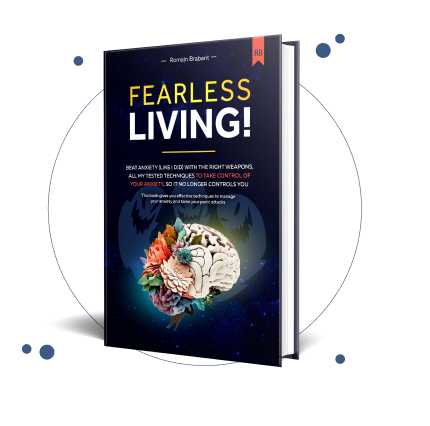
Building a support system isn't just about finding people to talk to; it's about intentionally creating a network that provides emotional, practical, and informational backup, reminding you that healing is possible. It all starts with one core idea: you don't have to face anxiety alone. The next step is to proactively identify and nurture connections that offer strength, hope, and understanding on your journey to a panic-free life.
Why Connection Is Your First Step to Healing
Living with anxiety can feel incredibly isolating. It’s like you're stuck navigating a relentless storm while everyone else seems to be on solid ground. There's a common, damaging myth that recovery is purely a test of personal strength—something you just have to "tough out" by yourself.
But the most powerful truth is that healing begins with connection, not solitude.

Reaching out isn’t a sign of weakness. In fact, it's one of the most courageous and hopeful steps you can take toward reclaiming your peace of mind and leaving panic behind.
Learning how to build a support system isn't meant to be another overwhelming task on your to-do list. Think of it as laying a hopeful foundation for a life less defined by anxiety. This network becomes your safety net, a web of people and resources ready to catch you and remind you that you can heal.
The Science Behind Social Support
This need for connection is more than just a feeling—it’s baked into our biology. Decades of research have shown a crystal-clear link between our social relationships and our overall well-being.
In fact, people with strong social ties have a 50% greater likelihood of survival compared to those with weaker connections. That's a profound finding. It shows how a solid support system literally acts as a buffer against stress, helping you regulate your emotions and build the resilience needed for recovery.
This isn't about having a massive circle of friends. It's about cultivating a few meaningful connections that provide different kinds of support on your path to healing.
Reframing Connection as a Path to Hope
Of course, anxiety—especially social anxiety—can make the very idea of building connections feel impossible. The thought of reaching out can trigger the exact symptoms you're trying to manage. If that sounds familiar, the key is to start small. You can learn more about managing these feelings in our guide to understanding social anxiety disorder.
Your support system can be made up of different people filling different roles. You might need:
- Emotional Support: Someone who can listen without judgment and validate what you're feeling, offering encouragement for the road ahead.
- Practical Support: A person who can help with a tangible task, like picking up groceries during a tough week, freeing up your energy for healing.
- Informational Support: A professional or peer who can offer solid advice, point you to resources, or share a new perspective that sparks hope.
To help you get started, we've created a simple blueprint. Think of it as a map to help you identify what you need and where you might find it.
Your Personal Support System Blueprint
This framework is designed to help you organize your thoughts and see your support system from a new angle. It breaks down the different types of support you might need and gives you ideas for where to start looking.
| Type of Support | What It Looks Like | Potential Sources |
|---|---|---|
| Emotional | A non-judgmental ear, empathy, validation of your feelings, encouragement. | Close friends, trusted family members, a therapist, a support group. |
| Practical | Help with tangible tasks like errands, childcare, or cooking a meal. | Family, neighbors, community organizations, a partner. |
| Informational | Advice, resources, professional guidance, shared experiences of recovery. | Therapists, doctors, online forums, books, peers with similar experiences. |
| Companionship | Simply being with others to reduce feelings of isolation and loneliness. | Hobby groups, volunteer organizations, social clubs, workout buddies. |
Use this table not as a rigid checklist, but as a flexible guide. You might find that one person fills multiple roles, or that you need to seek out new connections to fill certain gaps. The goal is to build a balanced and reliable network that feels right for you.
The goal isn't to find one person who can do everything. It’s to build a team. Each person plays a different role, and together, they create a resilient structure that empowers you to heal from anxiety and live a full, panic-free life.
Finding Support You Already Have
When you're deep in the grips of anxiety, it’s incredibly easy to feel like you’re completely on your own. Your world can shrink, and the narrative that "no one gets it" or "there's no one to turn to" can feel like an undeniable truth.
But here’s the thing: more often than not, the foundation of a support system is already there. You just need a new lens to see it. This isn't about forcing connections; it's about gently acknowledging the people who are already in your orbit, ready to offer a glimmer of hope.
A great first step is to create a simple "support inventory." This isn't some high-pressure performance review of your friendships. Think of it as a quiet, low-stakes exercise to map out the people in your life, recognizing that support shows up in all sorts of ways. Even the smallest positive interactions can be a source of strength.
Mapping Your Existing Connections
Think bigger than just your closest family or best friends. The goal here is simply to notice the web of connections around you, no matter how minor they might seem.
Consider the different kinds of supporters you might already have:
- The Confidant: This is your go-to person when you're overwhelmed. They listen without immediately jumping in to "fix" everything. It could be a sibling, a lifelong friend, or a partner who just lets you talk it out.
- The Practical Helper: This person shows up through actions. Maybe it’s a neighbor who can watch your dog in a pinch or a coworker who has your back and covers a shift when you're having a rough day. Their support is tangible.
- The Casual Uplifter: These connections might seem small, but their impact is huge. Think of the friendly barista who remembers your order or a fellow regular at the gym who always offers a smile. These brief, positive moments can cut right through the fog of anxiety.
The infographic below breaks down a simple way to think about identifying these needs and supports.
As the visual shows, building a support system starts with looking inward, then moves to sorting out who does what, and finally helps you prioritize. By simply taking stock of who is already around, you stop feeling like you're starting from scratch. That alone can build a little confidence and hope.
Seeing Hope in What's Already There
Once you've made a mental or physical list, just sit with it for a moment. You probably have more people in your corner than your anxiety lets you believe.
This simple act of recognition is a powerful step. It proves that connection is still possible and that you are not as isolated as you feel.
Realizing you have a starting point—however small—is a crucial shift. It moves you from a place of hopelessness to a position of potential. This inventory isn't your final support system; it’s the solid ground you can begin to build upon for a brighter future.
This process is a core part of reclaiming a sense of control. For a deeper dive into turning these initial steps into a sustainable practice, our resources at Anxiety University can offer more structured guidance. Acknowledging existing support reveals the tangible hope that is already present in your daily life.
Figure Out What Support You Actually Need
Once you have a sense of who is already in your corner, it's time for a little honest self-reflection. This isn't about judging your relationships. It's about getting real about what you truly need to feel supported as you navigate your way out of anxiety. Understanding your specific needs is a massive step toward getting your life back from panic.
Anxiety can be a moving target. Some days, you just need a friend who will listen without trying to fix anything. Other times, what you really need is practical help to get through a tough moment. When you can name what you need, you can start building a support system that truly works for you and accelerates your healing.

This process shines a light on the gaps in your network. Maybe your friends are amazing for a fun night out, but you don't have anyone who can just sit with you while you're feeling awful. That's not a failure—it's just a crucial piece of information that can guide you toward greater peace.
Get Specific About Your Needs
Take a few quiet moments and think about what happens when your anxiety is at its worst. Cast your mind back to the last time you felt totally overwhelmed or had a panic attack. In that exact moment, what did you wish someone would do for you?
Use these prompts to get your thoughts flowing. There are no right or wrong answers here, only what’s true for you.
- When I'm anxious, I wish I had someone to… (e.g., just listen without judgment, distract me with a funny story, send a quick "thinking of you" text).
- During a panic attack, a practical task that feels impossible is… (e.g., making a phone call, running to the grocery store, figuring out what to cook for dinner).
- I'd feel truly understood if someone could just offer me… (e.g., reassurance that this feeling isn't permanent, validation that my fear feels real, a gentle reality check).
Answering these questions transforms that vague feeling of "I need help" into a concrete, actionable list. This kind of clarity is one of the essential steps for anxiety recovery because it empowers you to ask for exactly what you need to heal.
Emotional vs. Practical Support: Know the Difference
Your needs will probably fall into two big buckets. It’s incredibly helpful to know which is which so you can turn to the right people at the right time.
- Emotional Support: This is all about connection and empathy. It’s needing someone to validate how you’re feeling, remind you that you're not alone, and just be present with you in the struggle, holding space for hope.
- Practical Support: This is about tangible, real-world help. It’s needing a hand with something that anxiety has made feel completely overwhelming, like a ride to a doctor's appointment or help watching the kids for an hour.
Understanding this distinction is a game-changer. You won’t get frustrated asking your most practical, problem-solving friend for deep emotional validation. And you won't feel let down when your most empathetic friend doesn't offer to run your errands. It’s all about matching the right need to the right person.
When you get this intentional, you start building a support system that's not just bigger, but smarter and more resilient—one that truly fits your personal journey toward healing and a panic-free life.
Expanding Your Circle with Gentle Intention
The thought of meeting new people when you're already dealing with anxiety can feel like being asked to climb a mountain in a thunderstorm. Let’s be honest, it’s a huge ask. It’s completely understandable to feel that way.
But building out your support system doesn't have to be another source of pressure. Think of it less as a chore and more as a gentle, intentional process—one that can bring a little hope and light back into your life.
The key is to reframe the goal entirely. This isn't about becoming a social butterfly overnight. It’s about creating small, safe opportunities for connection in ways that feel manageable and, eventually, even empowering. This is how you start building a network that helps you heal.
It all starts with your interests. What genuinely brings you a spark of joy or a moment of peace? Those hobbies are your secret gateways to low-anxiety social interactions.
Finding Connection Through Shared Interests
Joining a group that’s centered around a common activity immediately lowers the stakes. The intense pressure to make brilliant conversation just melts away. The activity itself becomes the focus, allowing connections to form naturally and at your own pace. The goal here is just to be around people, not to perform for them.
Think about low-pressure options like these:
- A local book club: Discussions are already structured around the book, giving you built-in topics to talk about.
- A community gardening group: You can work alongside others, enjoying shared silence or jumping into light conversation only when you feel comfortable.
- A hiking or walking club: The focus is on the movement and the scenery, not on constant chatter.
- Volunteering for a cause you believe in: Working toward a shared goal creates a powerful and genuine sense of camaraderie.
This whole approach is about taking small, hopeful steps. Imagine someone with social anxiety joining a yoga class. At first, their entire goal might be just to show up and unroll their mat. That’s it. For weeks, the comfort comes from the shared silence and collective breathing.
Over time, a simple nod to a fellow classmate becomes a brief "hello," and eventually, a short chat after class. It’s a slow, gentle unfolding—not a sudden, terrifying leap.
Hope is built on small, repeatable actions. Your goal isn't to conquer social anxiety in one day. It's to have one brief, positive interaction that proves to your nervous system that connection can be safe and healing.
Starting Small and Building Momentum
You don't need to jump into a weekly commitment right off the bat. The real goal is to accumulate small wins that build your confidence and prove that a life with less anxiety is possible.
Start with the tiniest possible step. Aim for one positive, low-stakes interaction a day. This could be as simple as making eye contact and smiling at the grocery store cashier or genuinely thanking the bus driver.
There's actually a powerful lesson we can learn from how large-scale support systems work. The expansion of global humanitarian aid shows how decentralized networks build resilience. In crisis zones, organizations reached nearly 116 million people by empowering local leaders and deploying innovative assistance. You can find more insights on these community networks on the UNOCHA website.
Just like them, you can build your own personal resilience by creating small, local points of connection.
This approach reminds us that a support system isn’t some single, monolithic structure. It’s a web of many small, meaningful links. Each new link you add, no matter how minor it seems, reinforces the entire structure, making you stronger and more capable of weathering any storm anxiety sends your way.
Weaving Professional Support into Your Network
While friends and family are your emotional bedrock, some parts of the healing journey call for a guide with a different kind of map. Bringing a professional into your support network isn't a sign that your personal connections have failed. Think of it as a smart, courageous move to build a truly unshakable system for your recovery.
This adds a powerful new dimension to your ability to heal from anxiety and live a life free from panic.
Therapists, counselors, and support group facilitators bring specialized tools and a confidential space to the table. They’re trained to help you unpack the roots of your anxiety, challenge the thought patterns that keep you stuck, and build concrete strategies for moving forward. It’s the perfect complement to the love and care you get from your people, providing a structured path to lasting freedom.

Different Roads to Professional Help
The world of mental health support isn't one-size-fits-all, and that's a good thing. Finding the right fit is what makes the process feel hopeful and genuinely productive.
Here are a few of the most effective options out there:
- Individual Therapy: This is your dedicated, one-on-one time with a licensed professional. Approaches like Cognitive Behavioral Therapy (CBT) are incredibly effective for anxiety because they teach you to spot and reframe the cognitive distortions that fuel panic, paving the way for recovery. You can learn more about how psychotherapy for anxiety works in our in-depth guide.
- Support Groups: Whether led by a facilitator or your peers, these groups connect you with people who just get it. There's immense power and hope in sharing your story in a safe space—it can instantly dial down the feelings of isolation.
- Online Communities: Moderated forums and digital mental health platforms offer accessible, and often anonymous, support right from your own home.
Getting Past the Roadblocks
Knowing you could use some help and actually getting it are two very different things. Let's be real: barriers like cost, stigma, and just finding the time are completely valid. But there are ways to work around them. Many therapists offer sliding-scale fees based on your income, and it's always worth checking what your insurance plan covers for mental health services.
Employer-provided resources are another potential avenue, though their quality can be a mixed bag. A global workplace mental health report found a major gap, noting that only 19% of caregivers feel they have adequate mental health support through their jobs. This is pushing companies toward more specialized, modern care options to better support their teams.
Professional support doesn't replace your friends and family. It’s an expert consultation for your mental well-being, giving you a personalized roadmap to navigate anxiety with more confidence and hope for a panic-free future.
Remember, reaching out for this kind of help is an act of empowerment. It shows a deep commitment to your own healing and is a crucial piece of building a support system that truly has your back.
Common Questions (and Fears) About Building Support
Let's be honest: building a support system when you're already drained by anxiety can feel like being asked to run a marathon when you can barely get out of bed. The idea itself can bring up a lot of fears and "what-ifs."
That's totally normal. Let's walk through some of the most common worries together, with real, practical answers to help you take that next hopeful step with more confidence.
What If I'm Too Anxious to Meet New People?
This is probably the biggest and most valid hurdle. The good news? You don’t have to dive into the deep end. The whole idea is to start small and find ways to connect that feel safe and healing, not terrifying.
Forget crowded parties for now. Try dipping your toes into low-pressure online communities. Find a group centered around something you actually enjoy—maybe it's a subreddit for your favorite video game, a Facebook group for gardeners, or a forum for fans of a specific author. This lets you connect over a shared passion first, which takes all the pressure off of painful small talk.
Another fantastic strategy is what I call "parallel activities."
- Try a painting or pottery class: You get to be creative right alongside other people, but there's no pressure to keep a conversation going.
- Volunteer at an animal shelter: The focus is on the animals, which instantly creates a calm, shared purpose.
- Join a quiet yoga or meditation group: Sometimes, just sharing a quiet space with others is a powerful form of connection in itself.
In settings like these, friendships can happen naturally over time, without feeling forced. And remember to celebrate the tiny wins—a quick, pleasant chat with the librarian or the person at the coffee shop counter counts. Each small step builds momentum toward healing.
The goal isn't to magically erase your social anxiety. It's to gently show your nervous system that connection can actually be safe and restorative. Every small success is proof that you can heal and live a fuller life.
How Do I Ask for Help Without Feeling Like a Burden?
That feeling is almost always your anxiety talking. It spins this story that your needs are an inconvenience, but the truth is, the people who care about you want to help. They just usually have no idea how.
The secret is to get specific. A vague cry for help like, "I'm so anxious," leaves people feeling powerless and unsure of what to do.
Instead, give them a clear, manageable request.
- "I'm feeling really spun out today. Would you be free later for a 10-minute call to talk about something totally light and distracting?"
- "The thought of going to the grocery store feels impossible right now. If you're heading there anyway, could you grab a few things for me?"
A specific ask is so much easier for someone to say "yes" to. It makes them feel genuinely helpful, not like you're dumping a huge, undefined problem on them. This is how you build a healthy two-way street, creating a balanced relationship where you're there for each other.
What If My Friends or Family Just Don't Understand?
This one hurts. It can be incredibly painful when the people you love just don't seem to get what you're going through. You can try to gently educate them—maybe by sharing a simple article or video that explains what anxiety actually feels like.
Using "I" statements can also bridge the gap. Try something like, "When I have a panic attack, it feels like I'm completely losing control. What helps me most is just knowing you're there and not judging me." You could even share practical tools; our guide on breathing exercises for anxiety has simple, shareable strategies they can learn.
But here’s the tough-but-important truth: you have to accept that not everyone in your life will be able to give you the exact support you need. And that’s okay.
This is precisely why building a diverse support network is so critical. The friend you call for a funny movie distraction might be different from the peer in your support group who knows just how to listen. A therapist can offer the specialized, professional understanding your family might not be equipped to provide. Each person plays a different, valuable role in your journey to recovery.
At The Anxiety Checklist, we see building a solid support system as a non-negotiable step toward a life with less fear. Our self-help system gives you the tools not just to manage anxiety in the moment, but to build the resilient, meaningful connections that make lasting recovery and a panic-free life possible. Find out how you can start your journey today at https://anxietychecklist.com.

